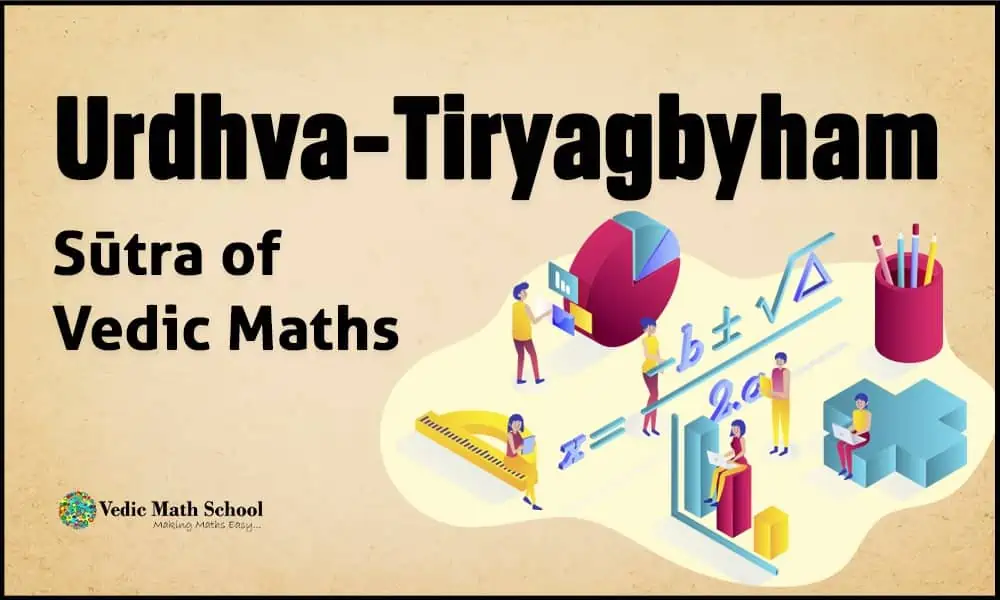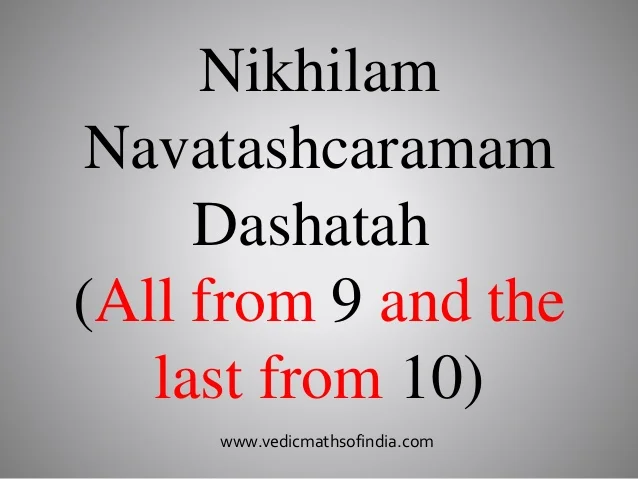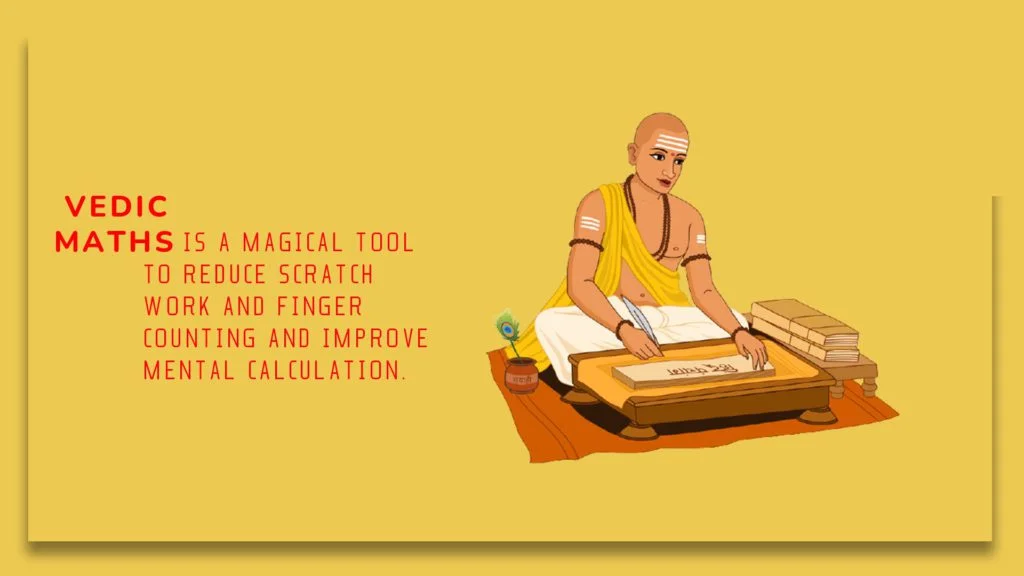Like the Nikhilam Sutra, the Anurupyena Sunyamanyat is another sutra in Vedic Mathematics This sutra is another method for multiplication. The difference between the two sutras is that the former method was used to multiply numbers closer to the power of 10 whereas this particular sutra is used to multiply numbers that are closer to each other.
The English translation of the above is proportions/many forms. This means that a particular number can be written in various ways for eg: 3 can be written as 6/3 or 18/6 or 1*3 etc.
Before we begin with the how this Sutra works, it is advisable to go through the Nikhilam Sutra and the Vinculum process.
Nikhilam Process
Let us take two numbers, 94 and 92 for multiplication. The Base for both these numbers is 100 as it is the closest.
- Make two separate columns. Write 94*92 in column 1
- Column 2 – 94 is 6 less than 100 and 92 is 8 less than 100.
- Now multiply (-6) * (-8) in column two which gives us 48
- Now we subtract digits diagonally written in column 1 and column 2 i.e we will subtract 8 from 94 and 6 from 92. Both give us the answer 86
- The last step is to append both these answers which give us the final digits as 8648. And here is our answer!

Let’s start with some examples to understand this method of division:
The Working Base concept:
This sutra applies to numbers that are not closer to the power of 10. If the numbers are closer to 70 the working base will be taken as 70 (10*7) instead of 100. Here the factor is 7. If numbers are closer to 50, we take the working base as 50 (10*5) or (100/2). Here the factors are 5 and 2 respectively.
Example 1.
We will take 2 numbers 62 and 66
- The working base = 60 which can be written as (10*6)
- Now as we learned in the Nikhilam procedure, 62 is 2 more than 60 and 66 is 6 more than 60.
- Therefore, in a separate column (+2) and (+6) will be mentioned.
- Cross addition of both numbers i.e. (62+6) and (66+2) both will give 68.
- Vertical multiplication of the right side will give us 12.
- Now we have 68/12 as the first set of answers.
- As the numbers are not closer to any power of 10 and we have 6 as our common factor ,therefore, the next step is to multiply 6 to the left side of the answer i.e. (68*6) = 408.
- Using the last step of the Nikhilam method where we carry forward numbers the final answer from 408/12 will turn out to be 4092.
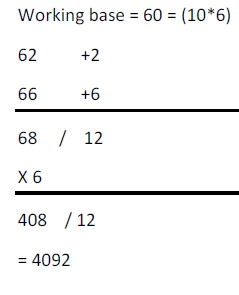
Example 2.
We will take 2 numbers again, 53 and 57. Both these numbers have a working base of 50. 50 can be written as both 100/2 and 10*5. Here, we will take our working base as 100/2.
- The working base = 50 which can be written as (100/2)
- Now as we learned in the Nikhilam procedure, 53 is 3 more than 50 and 57 is 7 more than 50.
- Therefore, in a separate column (+3) and (+7) will be mentioned.
- Cross addition of both numbers i.e. (53+7) and (57+3) both will give 60.
- Vertical multiplication of the right side will give us 21.
- Now we have 60/21 as the first set of answers.
- As the numbers are not closer to any power of 10 and we have 6 as our common factor ,therefore, the next step is to divide 2 from the left side of the answer i.e. (60/2) = 30
- Therefore, our final answer will be 3021.
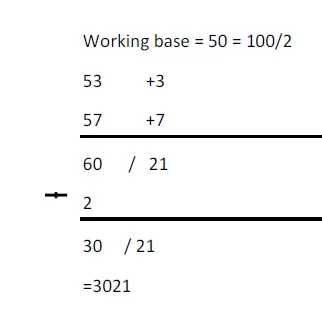
Example 3. (Using Vinculum method)
Vinculum numbers are those numbers that have 1 negative digit or have a Bar over them (indicating that it is a negative digit).
Through the Place Value System in Vedic Math normal numbers are written as:
2345= 2000+300+40+5
These when they have a bar over them can also be converted into normal numbers. For eg-:
2345= 2000+300-40+5 = 2265
Hence in the above example, the normal number for the above equation is 2265.
Another approach for the same is a process where we start from the right and go to the left. This is a trickier method by is very useful for numbers that have more number of digits.
Suppose we take the number 52113278235.
Now to convert this into a normal number, we will follow the below-given steps and move from right to left.
- Find the 1st bar digit in the above- given number which in this case is 3 (from the right) and take its 10’s complement.
- To find the “complement” of a number we subtract the given digit from the number. For eg: The 10’s complement for the number 7 is 3 (10-7)
- A) If the next digit is a bar digit, take its 9’s complement. Continue until you reach a non-bar digit.
B) Decrement non-bar digit by 1.
- Continue steps 1) and 2) until the whole number is covered.
Therefore, the normal number in the above case will come out to be as 47913122175.
Let us take two numbers 52 and 48. The working base for both these numbers is 50 as the numbers are closer to 50.
- The working base = 50= 10*5
- According to the Nikhilam procedure, 52 is 2 more than the working base which is 50 and 48 is 2 less than the working base. Mention it in one column
- Mention (+2) and (-2) in a separate column.
- Cross addition of both the numbers i.e. (52-2) and (48+2) both will give 50.
- Next we will vertically multiply the right side i.e. (+2-2). Since the working base has multiplication hence we require a 1 digit number. Hence we get BAR 4.
Now we have 50/4.
- As the numbers are not closer to any power of 10 and we have 5 as our common factor, therefore the next step is to multiply the left side of the answer from 5 i.e.(50*5) = 250
Again the next set of answers is 250/4.
- Using the vinculum process our final answer will turn out to be 2496.
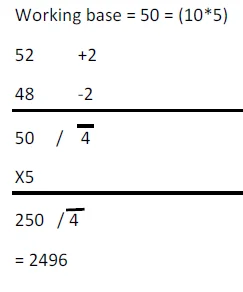
Share with your friends



